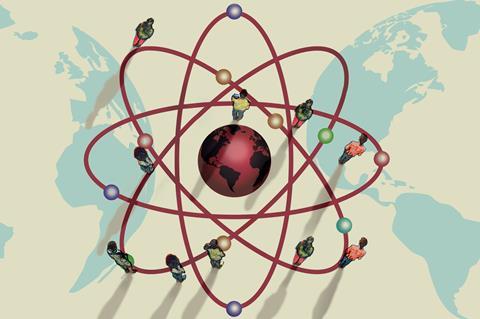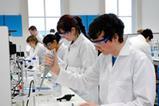There’s never been a more exciting and important time for students to pursue a career in chemistry

The ongoing debate about climate change, the environment and the actions that will be required to avoid the damaging effects of global warming and to arrest an ever-increasing loss of biodiversity were the principal focus of the recent COP26 conference in Glasgow. Many of the required actions will be social and economic in nature, but there are also many technological challenges which will have to be addressed – and a great many of these will require the knowledge and skills of chemists.
In a recent Chemistry World article, we wrote about our concern regarding the decline in applications to study chemistry at university, and the adverse impact this will have on universities and businesses and industries that employ chemists. Whatever the reasons for this decline, chemistry is an essential core discipline that will contribute to the inter- and multidisciplinary research required to solve or mitigate many of the challenges we face. What follows is by no means an exhaustive list of those challenges. However, we hope that the examples we’ve chosen, and the summaries of cutting-edge research aimed at your 14–16 students, will help to inspire those thinking of further study in chemistry.
Hydrogen
Many countries have set 2050 as their target date to achieve net-zero carbon emissions. This will require a significant reduction in their use of fossil fuels, particularly for transport. For certain applications, one alternative is hydrogen, but current industrial scale production involves the steam reforming of natural gas, which also produces carbon dioxide: CH4 + 2H2O → CO2 + 4H2
So-called ‘green hydrogen’, which does not produce CO2 as a by-product, will need to be derived not from hydrocarbons, but from water. It will also need to be produced either photochemically, using sunlight, or electrochemically, using electricity generated from renewable (solar and wind) or nuclear sources. However, many transport applications will require novel, solid-state hydrogen storage materials as an alternative to compressed gas.
-

Link to research involving hydrogen
Give context to the Haber–Bosch process with this one-slide summary and questions from What’s carbon dioxide got to do with it?
Hydrogen is also required at scale for a number of industrial processes – one of the most important being the synthesis of ammonia using the Haber–Bosch process (3H2 + N2 → 2NH3). Much of the ammonia produced is the feedstock for nitrogen-based fertilisers, but although the reaction is exothermic it requires high temperatures (400–500˚C) and pressures (~100 atm) to proceed at an appreciable rate, even in the presence of catalysts. It’s been estimated that around 2% of global energy production is used in making ammonia by this method, so any developments which can reduce the temperature and/or pressure will result in considerable energy savings.
Fuel cells and batteries
Fuel cells are an attractive source of electrical power for rail and some road transport applications. A number of prototype buses and trains powered by hydrogen fuel cells are currently being tested, but significant improvements are needed in fuel cell reliability and lifespan.
-

Link to research in fuel cells and batteries
Teach about lithium recycling and life-cycle assessments with this one-slide summary and questions from Recycling electric vehicle batteries.
Besides fuel cells, batteries will be required in ever larger quantities for the electric vehicles which will increasingly replace those with internal combustion engines. However, not only will battery performance and charging times need to be improved, consideration must also be given to recycling, not least because many of the elements used in battery construction – lithium and cobalt, for example in lithium-ion batteries – are not common and known reserves are finite and/or obtained from conflict zones. It would be better still if batteries using more earth-abundant elements could be developed.
Strategic elements
Smartphones and the infrastructure that supports their use are the result of incredible technological achievements. Most would find it hard to imagine life without them. However, their manufacture requires the incorporation of many advanced electronic materials and over 30 elements are used in their construction. Six of these elements – Ga, As, Ag, In, Y and Ta – are derived from sources which, at the current rate of use, are expected to be exhausted in 100 years or less. Like batteries, large-scale and efficient recycling will be essential along with component materials which employ more earth-abundant elements.
-

Link to research in strategic elements
Give context to lithium-ion batteries with this one-slide summary and questions from How the Nobel prize winners helped develop mobiles.
Biofuels and synthetic fuels
Hydrocarbon fuels are likely to continue to be required for aviation in the near to medium term due to the excessive weight penalties associated with current alternatives (batteries are heavy). But continued use of fossil fuels is not sustainable. Biofuels produced from biomass and synthetic fuels derived from atmospheric CO2 and green hydrogen are attractive alternatives, since the CO2 they produce is recycled in their production.
-

Link to research in biofuels
Give context to renewable fuels with this one-slide summary and questions from Making ethanol from lignin.
Plastics and composites
Plastics are ubiquitous and find application in just about every aspect of modern society, many good but some bad. Focusing on just one aspect, single-use plastics will increasingly be phased out, at least those which pose a threat to the environment. Plastics derived from biomass and/or plastics which are biodegradable offer an attractive alternative for some applications.
-

Link to research in plastics and composites
Teach about upcycling with this one-slide summary and questions from How microbes convert waste plastic bottles into vanillin.
A problem with composite materials, which are essential for wind turbine blades, for example, is that they are not yet easily recyclable and the resins used to make them also need to be greener. Future self-healing composites will also offer products with extended lifetimes which will help to reduce waste.
To achieve all this, we need chemists
Clearly there are many technological problems associated with global challenges which need to be solved, a few of which we’ve highlighted here. Some, such as biofuels or synthetic fuels, may only provide a stopgap between fossil fuel use and fully electric propulsion, but will nevertheless be important in the short to medium term. It’s clear that chemistry will have a central role in almost all of the necessary research and development.
This is why there has never been a more exciting and important time to pursue a career in chemistry. Nor has there ever been a period of greater opportunity to contribute to addressing the challenges we all face, and which will most certainly impact all of our lives.
Article by Nick Norman, a professor of inorganic chemistry at the University of Bristol, and Vernon Gibson, an honorary professor in materials/chemistry at the Universities of Oxford, Manchester and Imperial College London
Introduce chemists to your students

- Meet Ryley, a solar technology engineer, and Maria Conway, a section leader in the wind sector.
- Watch the videos of Dr Zubera Iqbal, a research fellow in battery recycling.
- Show how chemistry knowledge and skills can be applied in project management with Trevor Keel’s video job profile.
- Meet Florence Gschwend, a chief technology officer and co-founder of Lixea, a sustainable solutions company.
- Watch the video job profiles of Celine Moreira, an analytical technician in plastics, and Margot Wenzel, a research innovations manager fighting the war on plastics.
Find more materials to promote chemistry careers and qualifications to your students on A future in chemistry.
Careers links and downloads
Find careers links and Science research news articles with one-slide summaries on all these topics from the Education in Chemistry website: rsc.li/3uqolVJ














No comments yet